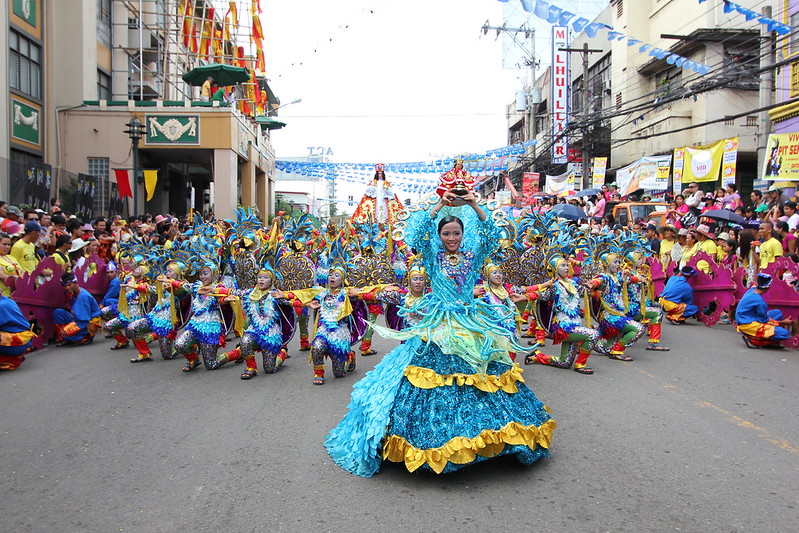Sinulog Santo Nino Festival
Cebu’s River of Faith and Color
2026/01/10 - 2026/01/17
Every January, Cebu City in the Philippines is wrapped in the vibrant energy and color of the Sinulog-Santo Niño Festival. For a whole week, locals and visitors fill the city streets, sharing their devotion to the Santo Niño (the Child Jesus) and the joy of celebration. The rhythm of the drums, sparkling costumes, and the passionate crowds—Sinulog is one of the Philippines’ biggest festivals, a feast for all five senses that draws you right into its swirling excitement.
Held every year on the third Sunday of January, this festival is the heart of Filipino culture—open to devotees, families, and travelers alike. The blend of religious solemnity and lively street revelry captivates everyone who visits.
Main Attractions
Sinulog Grand Parade
The festival’s biggest highlight is the Grand Parade, which winds its way through Cebu’s streets like a river. Dancers in dazzling costumes adorned with feathers and beads perform the unique “two steps forward, one step back” Sinulog step, mimicking the flow of a river (“sulog” in Cebuano). The beat of drums and gongs, the shout of “Pit Señor!”, and floats decorated with flowers and Santo Niño images all vividly tell the story of Cebu’s history and faith.
Key Events
Sinulog is more than just a parade. Each night brings street parties, concerts, and fireworks, along with nine days of novena Masses at the Basilica Minore del Santo Niño. The Fluvial Parade, where the Santo Niño image sails along the Mactan Channel on a decorated boat, is a highlight. Candle vendors perform the traditional Sinulog dance in front of the church, and the whole city buzzes with anticipation and blessings.
Costumes and Decorations
Participants wear colorful costumes inspired by indigenous, Spanish, and religious motifs. Sequins, feathers, beads, and shimmering skirts and capes are a feast for the eyes. Streets are strung with banderitas (colorful flags), and floats and altars decorated with flowers and Santo Niño images line the parade route. The scent of incense and candles blends with the tropical air, deepening the festive mood.
Traditional Food & Drink
Sinulog is also a celebration of food. Cebu’s famous lechon (roast pig), puso (rice wrapped in palm leaves), grilled seafood, and sweet mangoes are everywhere. The aroma of roasting meat, the tang of vinegar sauces, and the crunch of fried spring rolls whet the appetite, while cold sago’t gulaman and halo-halo help cool you down amid the excitement.
Cultural and Historical Background
The history of Sinulog dates back to the Age of Exploration in the early 16th century. In 1521, Portuguese explorer Ferdinand Magellan landed on Cebu Island during his circumnavigation of the globe and encouraged King Rajah Humabon and Queen Hara Amihan (or Juana) to convert to Christianity. As a symbol of their conversion, Magellan gifted the queen an image of the Child Jesus (Santo Niño). The queen, overjoyed, danced with the statue in her arms, and her attendants joined in. This dance is said to be the origin of today’s Sinulog dance, and the “two steps forward, one step back” movement seen in the Grand Parade represents the flow of a river (“sulog” in Cebuano).
The Santo Niño image became the spiritual heart of Cebu, blending indigenous rituals with Catholic traditions. Through the Spanish colonial era, Sinulog evolved from a religious ceremony into a national festival symbolizing Cebu’s history, culture, and pride. Today, the week-long celebration features parades, Masses, traditional dances, and the Fluvial Parade, drawing over four million people from the Philippines and around the world.
Sinulog tells the story of Christianity’s arrival in the Philippines and stands as a symbol of faith, pride, and unity for the people of Cebu. Passed down for centuries, it remains a living tradition, full of passion and meaning for every new generation.
Participant Voices
I was overwhelmed by the scale and energy. At dawn, I joined a local family to watch the Fluvial Parade, sending off the Santo Niño’s boat together. Seeing everyone singing and crying moved me deeply.
Fun Facts
- “Sinulog” comes from the Cebuano word “sulog” (river current), and the dance steps mimic the flow of water.
- “Pit Señor!” is an old Cebuano phrase meaning “Pray to the Lord!”
- Sinulog is celebrated not only in Cebu, but also in Filipino communities across the Philippines and around the world.
Festival Dates
The Sinulog-Santo Niño Festival is held every January in Cebu City, Philippines. The Grand Parade takes place on the third Sunday of January.
The event schedule is subject to change. Please check the official website for the most up-to-date information.
Information
| Name | Sinulog Santo Nino Festival |
| Country | Philippines |
| Area | Cebu |
| Date | 2026/01/10 - 2026/01/17 |
| Link |
Upcoming Festivals
Dia de la Virgen de Guadalupe Mexico
A Festival Weaving Faith, Fervor, and Mexican Identity
2025/12/11L'Escalade Switzerland
Geneva’s Grand Winter Festival of Courage, Chocolate, and Community
2025/12/12Umkhosi Wokweshwama South Africa
The Zulu First Fruits Festival—A Sacred Celebration of Land, Ancestors, and Renewal
2025/12/12Lucia Festival (St. Lucia's Day) Sweden
A Festival of Light Illuminating the Nordic Darkness
2025/12/15Las Posadas Mexico
The Luminous Quest for Sacred Shelter
2025/12/22Noche de Rabanos (Night of the Radishes) Mexico
A celebration blending art, farming heritage, and cultural traditions
2025/12/23Chant of the Sybil on Majorca Spain
A Medieval Prophecy Echoes Through Majorcan Christmas
2025/12/23‘Hatajo de Negritos’ and the ‘Hatajo de Pallitas’ Peru
A Christmas Festival of Rhythm, Faith, and Afro-Andean Heritage in Peru’s Ica Region
2025/12/24Harbin International Ice and Snow Sculpture Festival China
A Frozen Wonderland Where Art and Adventure Merge
2025/12/24Takanakuy Peru
The Andean Festival of Reconciliation by Fist—How Confrontation Creates Year-End Peace and Bonds



